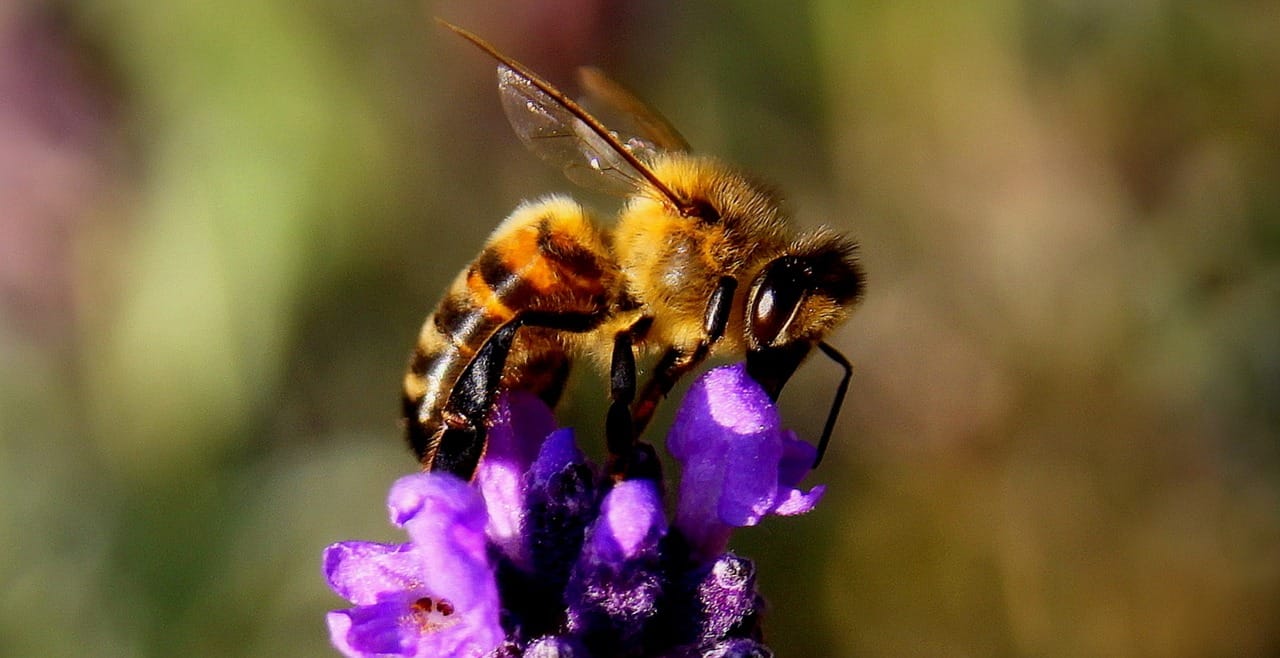[dropcap]T[/dropcap]he fascinating honey making process starts when worker bees leave the hive to collect nectar from flowers. The crazy thing is bees visit hundreds of flowers in a single trip just to fill a tiny “honey stomach”. The bee processes the nectar before it regurgitates it for another bee in the hive. That bee processes it again and spits it out. The bee then uses its wing to evaporate any excess water in the nectar. Finally the newly made honey is sealed with wax in the hive. Honey bees work so hard, yet one bee will only make about 1/12th of a teaspoon of honey in its life. It takes many bees to be helpful and they need to be protected.
Most people categorize bees as a nuisance. But in actuality, bees are far from it. Instead of being afraid or annoyed of bees, we should be reminded of how much bees do for us. Bees play a crucial role in agriculture, from pollinating your favorite fruits, to pollinating alfalfa and clover to feed cattle. It is amazing how such a small animal can make such a big difference.
Here’s the catch, bees are at risk. Lots of factors contribute to the decline of bees, but a few stick out. Bee habitats are on the decline and the ever growing use of pesticides are bad news for the bees. Diseases and nutrition also impact them.
Bees and Farming

Image by Pixabay
According to an article on Sustain, honey bees alone account for pollinating about 80% of US crops of blueberries and almonds. Bees play a crucial role in the agricultural economy. Many foods such as apples, melons, citrus fruits, avocados, soybeans, broccoli, and many more need to be pollinated by animals such as the bee. If bees are so important in the US, it makes sense that “[g]lobally there are more honey bees than other types of bee and pollinating insects, so it is the world’s most important pollinator of food crops. It is estimated that one third of the food that we consume each day relies on polination mainly by bees.”
In California, the Almond industry is heavily reliant on bees. California’s almonds are the state’s leading overseas agricultural export and account for 90% of the world’s almonds. Every year, California’s 800,000 acres of orchards need a whopping 1.6 million domestic bee colonies to pollinate the trees. This makes for an astounding number of bees when”[e]ach acre of almond trees requires approximately two hives to pollinate, and to produce a single nut it takes about a dozen bee visits.”[perfectpullquote align=”left” bordertop=”false” cite=”” link=”” color=”” class=”” size=””]”It is estimated that one third of the food that we consume each day relies on pollination mainly by bees”[/perfectpullquote]

Image by makamuki0
Honey
Bees produce honey by first gathering nectar from flowers. Then the honeybees go back to the hive and transfer the nectar to a worker bee. The worker bee then manipulates the nectar and divides it into the honeycombs. In the honeycombs, the nectar dries into a thicker syrup. This process converts nectar which has a large percentage of water and not a large percentage of sugar, into honey which has a low percentage of water and a high percentage of sugar. Sometimes bees will flap their wings to dry the nectar faster. The honey is sealed in the honeycomb with a layer of wax.
Honey is a source of antioxidants, enzymes, amino acids, and minerals. Honey naturally preserves itself. Honey used to be used to treat wounds in place of modern day antibiotics. Sealed honey can still be edible for centuries.
Threats to Bees
Habitat Loss
Natural bee habitats in North America are being replaced by roads, houses, and business complexes. Bees have less and less natural habitat to live in. With less food for bees, colonies can decline greatly. With a growing population, bees have a diminishing habitat.
Bees also perform better with more habitat to access. “In the United States, states with the largest areas of open land compared to developed land had a significantly higher honey yield on a per colony basis because of more foraging resources in the open land.”
Raising honey bees is necessary for our environment, lets hope everyone understands that… #startingabeehive #c… pic.twitter.com/e9epxjaZsB
— The Beekeeper (@thebeekeeperman) December 10, 2017
Pesticides
Pesticides are used a lot in commercial farming. They can be really harmful to bees, other pollinators, and the local ecosystems. Neonicotinoids are a class of insecticide that are really bad for bees. The chemical coats the seed and infuses into the plant as it grows. The chemical is then in the pollen so when a bee comes it is directly affected. The pesticide does not directly kill the bee, but it permanently impairs the bee from performing basic functions which causes it to die. Neonicotinoids are largely blamed for causing sporadic bee deaths even though it is not proven. In Europe, some countries have banned the use of neonicotinoids to see results.
Monocultures
Monocultures are created when one specific crop is grown in an entire field. Bees are crucial in pollinating some of these staple crops. Corn is bad for bees because it does not produce nectar which bees need. Also most corn seeds are coated with pesticides that will kill or severely weaken bees.
Monoculture also impacts the soil and the surrounding ecosystem of the crop fields. Bees benefit greatly from a diverse diet. A diverse diet makes stronger bees which leads to bigger, safer colonies. Small colonies are weaker against mites and parasites.
Colony Collapse Disorder
Colony collapse disorder, or CCD, is defined as when the majority of the worker bees in a colony simply leave, stranding the queen, food, and a some nurse bees. There are not enough bees to sustain the hive and they eventually die. There is no definite cause of CCD but researchers are focusing on factors such as the varroa mite, viruses, parasites, lack of nutrition, lack of good habitat, and the use of pesticides.
Varroa Mite
The Varroa mite is a mite that infests beehives and can wipe out an entire colony. The mites grow by consuming the blood developing bee brood. Adults attach to worker and drone bees and suck their blood, weakening them and shortening their life. As a brood develops in its cell, multiple mites could grow and reproduce until the cell is opened and the mites attach to bees. Varroa mites can spell disaster for colonies if hives are not examined for them.
Deformed Wing Virus (DWV) is associated with the varroa mite. In colonies with a large mite population, DWV is also usually prevalent. While some colonies with DWV do not have mites, colonies with mites suffer more when there are mites. DWV is just like it sounds, the wings are misshapen and often unusable. This virus disable bees and weakens the colony severely.
Why Can’t I Spray That Nest
Technically I can’t stop you, but by reading this article I hope that you can realize how much bees are beneficial to farming and the environment. Bees are not aggressive and won’t sting if you move slowly and do not swat or agitate them. There is no reason to be afraid of bees unless you are allergic (in that case you can still appreciate what they do for us).
Wasps and Hornets are predatory insects that are terrible pollinators compared to honey bees. Honey bees do so much for the environment and economy that we should protect their populations.In conclusion, bees have their own problems and the least you could do is not spray their nest to help them out.
Featured image by chezbeate





What do you think?
Show comments / Leave a comment